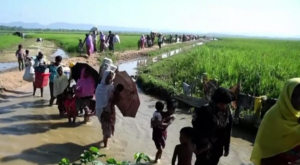Physical Address
23,24,25 & 26, 2nd Floor, Software Technology Park India, Opp: Garware Stadium,MIDC, Chikalthana, Aurangabad, Maharashtra – 431001 India
Physical Address
23,24,25 & 26, 2nd Floor, Software Technology Park India, Opp: Garware Stadium,MIDC, Chikalthana, Aurangabad, Maharashtra – 431001 India

On December 9, Pradyut Bordoloi, a Congress MP from Assam introduced the Climate Migrants (Protection and Rehabilitation) Bill as a private member’s bill in the Parliament. It was among the 50 bills that Parliamentarians mooted on December 9 as part of a discussion on the private members’ bills. Though either house rarely passes private members’ bills, the importance of a Bill involving climate change perhaps could no longer be brushed away at this point in time.
While introducing the bill, Bordoloi said it sought to “establish an appropriate policy framework for the protection and rehabilitation of internally displaced climate migrants and for all matters connected therewith”. The Bill provides for a dedicated climate fund and for periodic surveys in climate change-prone areas to assess the scale of the displacement.
In an interview with Scroll, the Congress MP explained the main motivation behind introducing the bill as ‘home-driven observations’. Bordoloi said that the inhabitants of the riverine islands in Assam become homeless all of a sudden and are forced to move and settle down in forest land, grazing areas, where the law prohibits human settlement. Since there’s no legal framework to protect these people, that was one of the main reasons behind the introduction of this bill, the Congress MP further said in the interview.
“…the waterflow in the Brahmaputra has become erratic. Earlier, you couldn’t see one bank from another, but now the same river has been reduced to a rivulet for many months of the year. Then suddenly, there’s heavy rainfall and there’s inundation. In short, there is now constant friction on the banks of the Brahmaputra,” Bordoloi said to Scroll.
Indians feel most likely to get displaced due to Climate Change
India has recently witnessed huge and unprecedented climate disasters in the form of heatwaves, droughts, cloudbursts, and floods. UN reports document that India is the seventh most climate change-affected country. Nearly 5 million people in India were internally displaced due to climate change, and disasters in 2021, according to a United Nations report. According to the data of the Internal Displacement Monitoring Centre (IDMC), in 2020, around 39 lakh people were displaced by environmental disasters which is around 1000 times more than the persons displaced by conflicts.
India topped among 34 countries in a global survey in terms of feeling most likely that they or their family will be displaced from their home as a result of climate change in the next 25 years. The survey was conducted by Ipsos for the World Economic Forum among 23,507 people in 34 countries between July 22 and August 5.
Almost two-thirds (65%) of those surveyed in India felt that it is likely that they will need to move in the next 25 years because of climate change. This was the highest percentage recorded in the survey. In India, 76% of those surveyed also said that they expect that climate change will have a severe effect in their areas over the next 10 years.
Why a Climate Migrants Bill?
While introducing the Bill, Bordoloi highlighted that the 2020 report of Action Aid and Climate Action Network stated that India had a total of 1.4 crore persons internally displaced due to climatic and environmental disruptions and projects that more than 4.5 crore people will be forced to migrate from their homes by 2050.
“Current national legislations and policies primarily address short-term and sudden-onset climatic disasters. However, slow-onset climate change events such as increased aridity and recurrent droughts of varying degrees, desertification, sea-level rise, glacial melt, riverine erosion and losses caused by the same, are largely not incorporated and therefore communities suffering the impact, are not within the ambit of protection and rehabilitation,” mentioned the bill’s statement of object and reasons.
While explaining the above point that our existing policies are geared more towards short-term and sudden-onset climatic disasters ignoring slow climatic changes Bordoloi said to Scroll, “The government of India defines calamities as events like floods. But take the case of Assam. Floods routinely occur there, twice or thrice a year, inundating large swathes of land. They subside in a week to 10 days. But the bigger problem is erosion, which is a year-long event. Because of erratic waterflow, thousands of hectares of cultivated land, homestead land are getting washed away constantly. But that is not considered a calamity. As a result, people don’t get any kind of support.”
“What we have now is a very short-term, almost ad hoc kind of policy. Events like erosion which occur around the year are not covered. So you have to revisit and readdress how we think of climate change,” Bordoloi further said in the Scroll interview.
The Bill’s statement of object and reasons also said that while much of the focus is on relief at the disaster site and addressing immediate issues of communities affected; their rehabilitation or support at destinations are concerns that remain unaddressed.
“With rising climatic and ecological stress on habitats, and a projected increase of climate-induced migration in the next decades, the need is to develop a comprehensive nationally integrated approach to develop with a view to address the causes, remedy effects, and protect communities impacted,” the Bill further stated.
“We will not see the legal culmination of this Bill, but it’s important for generating a national discourse. It may even inspire government legislation,” Bordoloi told the Ken.
Comments are closed.
[…] Also, read this in English […]